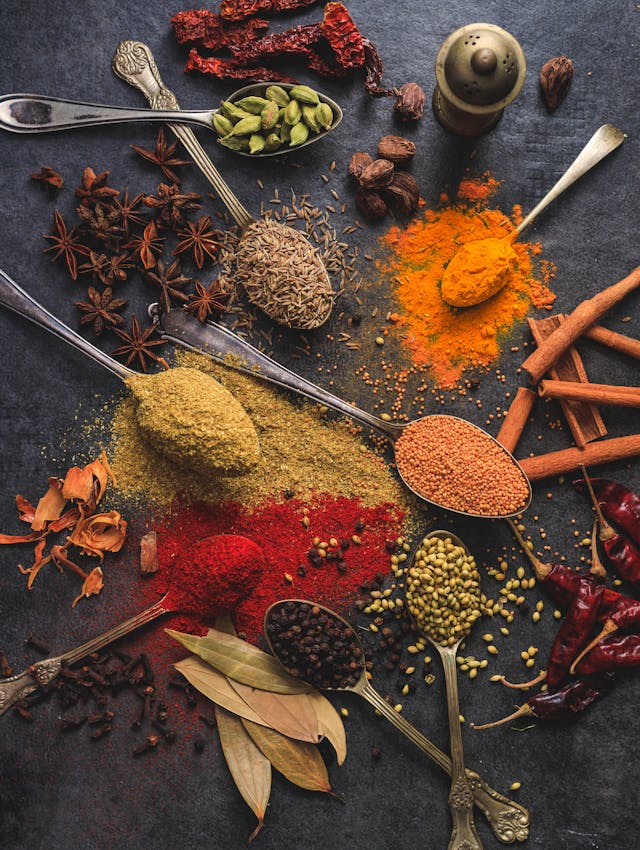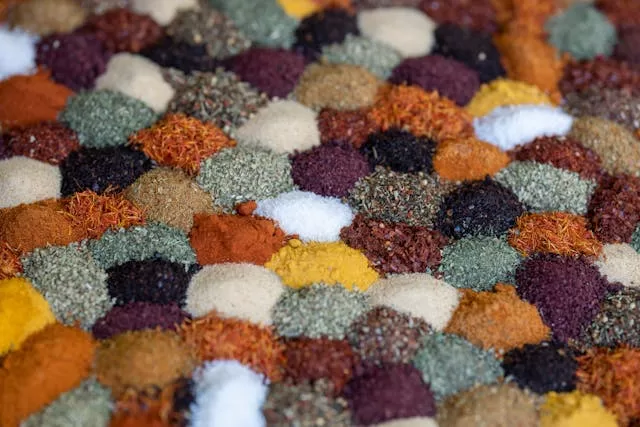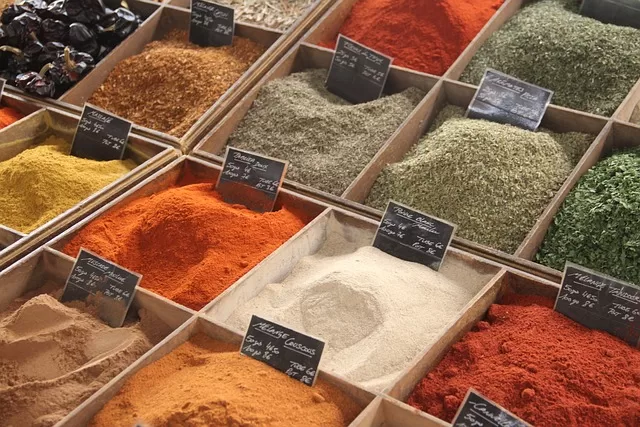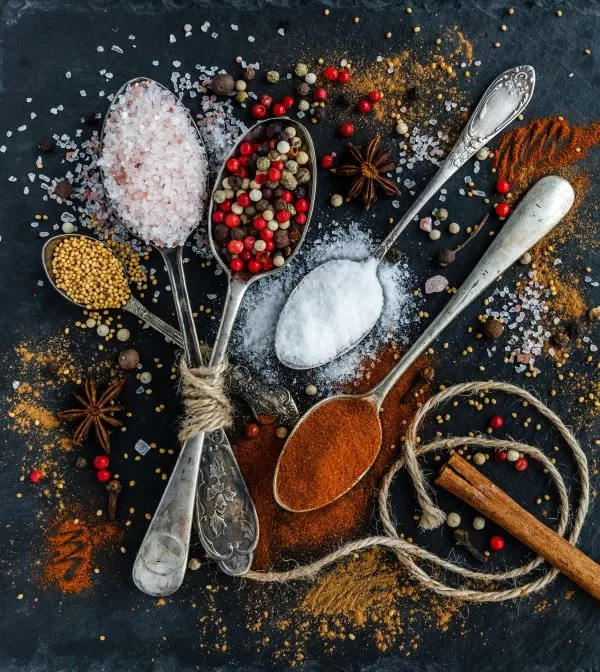What Are Spices?
Spices are natural substances derived from various parts of plants, including seeds, fruits, roots, bark, and leaves, used primarily to flavor, color, or preserve food.
Unlike herbs, which are typically derived from the leaves of plants, spices can come from other plant parts and are often used in a dried form. Here’s a brief overview of their key characteristics:
- Flavor Enhancers: Spices are primarily known for their ability to enhance the taste of food, adding depth and complexity to dishes.
- Color and Aroma: Many spices also contribute vibrant colors and distinctive aromas, making dishes more appealing.
- Preservation: Historically, spices have been used for their antimicrobial properties, helping to preserve food and extend its shelf life.
- Health Benefits: Many spices offer various health benefits, including anti-inflammatory properties, digestive aids, and contributions to overall wellness.
- Global Variety: Spices are integral to culinary traditions around the world, each culture having its own set of commonly used spices that characterize its cuisine.
Spices play a crucial role in cooking and have also been used in medicinal and religious rituals across different cultures and epochs. Their inclusion in a dish can transform the mundane into the extraordinary, both in terms of flavor and health benefits.
Table of Contents
Here are 27 essential cooking spices that you should consider stocking in your kitchen to enhance your culinary creations:
Food Spices List
- Black Pepper – Adds a sharp and mildly spicy flavor to dishes.
- Salt – Enhances the natural flavors of food; available in various types like sea salt, Himalayan pink salt, and table salt.
- Cumin – Earthy and aromatic, great for Mexican and Indian dishes.
- Cinnamon – Sweet and woody, perfect for both sweet and savory dishes.
- Chili Powder – Adds heat and depth to dishes, essential for Mexican cuisine.
- Paprika – Offers sweetness and color, ranging from mild to hot.
- Oregano – Earthy and mild, commonly used in Italian and Mediterranean cooking.
- Turmeric – Bright yellow with anti-inflammatory properties, key in curries.
- Garlic Powder – Adds a robust flavor, more concentrated than fresh garlic.
- Ginger – Spicy and sharp, used in sweets and savories alike.
- Nutmeg – Warm and nutty, often used in baking and on vegetables.
- Coriander – Offers a citrus-like flavor, perfect for spice mixes and marinades.
- Cardamom – Sweet and spicy, used in both desserts and savory dishes.
- Cloves – Intensely aromatic, good for spice blends and meat marinades.
- Bay Leaves – Adds a subtle depth to soups, stews, and sauces.
- Thyme – Adds a pungent, earthy flavor, great in most meat dishes.
- Rosemary – Woody and citrusy, excellent for roasts and breads.
- Basil – Sweet and peppery, essential for Italian sauces and salads.
- Saffron – Luxurious and flavorful, ideal for Spanish and Middle Eastern dishes.
- Tarragon – Anise-like flavor, commonly used in French cuisine.
- Fennel Seeds – Lightly sweet and licorice-like, great in sausages and stews.
- Mustard Seeds – Spicy and tangy, used in Indian cooking and pickling.
- Cayenne Pepper – Very hot and pungent, a little goes a long way.
- Allspice – Combines flavors of cinnamon, nutmeg, and cloves; used in baking and meat dishes.
- Star Anise – Licorice flavor, key in Chinese braising and in making pho.
- Sumac – Tangy and slightly fruity, adds a lemony flavor to Middle Eastern dishes.
- Dill – Light and feathery herb with a fresh, slightly sour taste.
Each of these spices can dramatically transform simple ingredients into exquisite dishes with layers of flavor. For tips on using these spices effectively and to explore recipes that showcase them, you might want to delve deeper into their individual characteristics and culinary applications.

What’s the Difference Between Cooking With Whole vs. Ground Spices?
Cooking with whole versus ground spices can significantly influence the flavor, aroma, and overall outcome of a dish. Both forms have their advantages and ideal uses in the kitchen. Here’s a closer look at the key differences:
Whole Spices
- Longer Shelf Life: Whole spices maintain their flavor and potency longer than ground spices because they have less surface area exposed to air.
- Flavor Release: They release flavor slowly, making them ideal for dishes that cook over an extended period, like stews and braises.
- Toasting Advantage: Whole spices can be toasted before use, which enhances their depth of flavor by releasing essential oils.
- Used for Infusing: Whole spices are often used to infuse flavor into oils, syrups, or poaching liquids, and can be easily removed before serving.

Ground Spices
- Immediate Flavor Release: Ground spices are best when you need an immediate burst of flavor, as their small particles integrate quickly with other ingredients.
- Convenience: They are more convenient and ready to use, which is ideal for quick cooking and baking where flavors need to meld rapidly.
- Intensity: Ground spices can offer a more intense flavor per teaspoon than whole spices, but this potency can dissipate quickly.
- Shorter Shelf Life: Because they are already broken down, ground spices lose their flavor faster and should be bought or ground in small quantities.
Choosing Between Whole and Ground Spices
- Cooking Time: For longer cooking dishes, whole spices are preferable as they impart subtle, complex flavors over time. For quick meals or baking, ground spices are more practical.
- Flavor Control: Whole spices allow for more controlled flavoring, as they can be added and removed easily. Ground spices blend thoroughly into dishes, which is useful for achieving uniform flavor distribution.
- Freshness Preference: If you prefer fresher, more vibrant flavors, grinding your own spices from whole forms right before cooking can make a noticeable difference.
In summary, the choice between whole and ground spices depends on the cooking method, the desired intensity of flavor, and how long the spices need to cook. Both forms are essential in a well-stocked kitchen to suit various culinary needs.

How to Store Your Spices
Storing spices correctly is crucial for maintaining their flavor, color, and potency. Here are some key tips on how to store your spices effectively:
- Keep Away from Heat: Heat can cause spices to lose their flavor rapidly. Avoid storing spices above your stove, oven, or any other cooking appliances that generate heat.
- Avoid Light: Exposure to light can fade the colors of your spices and degrade their quality. Opt for storing spices in a cupboard or drawer rather than on a countertop.
- Control Moisture: Moisture can lead to clumping and mold growth in spices. Make sure your storage area is dry. Avoid storing spices near the dishwasher, sink, or areas prone to steam.
- Use Air-Tight Containers: Air can also cause spices to lose their potency. Store spices in air-tight containers to minimize exposure to oxygen. Glass jars with tight-sealing lids, metal tins, or even vacuum-sealed bags are good options.
- Label and Date: Keeping track of when you bought your spices can help you use them while they are still fresh. Labeling each container with the name of the spice and the purchase or opening date is helpful.
- Optimal Containers: Dark-colored glass containers can help protect spices from light damage. If you use clear glass, be sure it’s stored in a dark place.
- Regular Cleaning: Routinely clean your spice storage area to avoid buildup of dust and spice residues, which can attract pests.
- Organization: Organize your spices in a manner that you can easily access them, keeping those you use most frequently at the front. Consider a spice rack that fits inside a cabinet door or a tiered shelf to make all jars visible.
- Cool Environment: A pantry or cabinet away from direct sunlight and heat sources is ideal. Ensure the environment is consistently cool to help prolong the shelf life of your spices.
- Check for Freshness: Periodically check your spices for freshness. Signs of aging include loss of color, diminished aroma, and lack of flavor. As a general rule, whole spices can last up to 4 years, ground spices up to 2-3 years, and dried herbs about 1-3 years.
By following these storage tips, you can help ensure that your spices retain their quality and elevate your cooking with maximum flavor.

FAQs About Cooking Spices
1. What spices should every kitchen have?
Every kitchen should have basic spices like black pepper, salt, cumin, cinnamon, and chili powder. These spices can be used in a variety of dishes and cuisines to enhance flavor.
2. How long can I store spices?
Whole spices can generally be kept for about 4 years, ground spices for 2-3 years, and dried herbs for 1-3 years. However, for the best flavor, it’s recommended to use them within one year of purchase.
3. How should I store my spices to keep them fresh?
Store spices in a cool, dark place in air-tight containers. Avoid exposure to heat, light, and moisture as these can decrease their potency and lead to spoilage.
4. Can I use old spices?
While old spices are not usually harmful, they lose their strength and will not effectively flavor your food. If a spice smells weak and is not as vibrant, it’s best to replace it.
5. What is the difference between herbs and spices?
Herbs are typically the leafy parts of plants used for flavoring or as garnish. Spices may come from the other parts of the plant: roots, bark, seeds, or fruits.
6. Is it better to use whole spices or ground spices?
Whole spices tend to keep their flavor longer and can be ground as needed. Ground spices are more convenient but lose their potency faster. The choice depends on how frequently you cook and your flavor preferences.
7. What is the best way to grind whole spices?
The best way to grind whole spices is with a mortar and pestle or a dedicated spice grinder. This allows for fresher flavors and finer control over the consistency of the spice.
8. Can spices be frozen for longer storage?
Yes, freezing spices can extend their shelf life. However, this might result in some loss of flavor potency. It’s generally best to store them in a cool, dry place.
9. How do I know if a spice is still good to use?
Check the color, smell, and taste. If the spice has faded in color, has a weak smell, or lacks flavor when tasted directly, it might be time to replace it.
10. Are there any health benefits to using spices in cooking?
Many spices offer health benefits, including anti-inflammatory properties, antioxidants, and other nutrients that can support health.
This FAQ section can help clarify common questions and enhance the reader’s understanding and use of spices, making your article more comprehensive and valuable.


